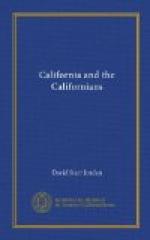In no way has the unearned increment been more mischievous than in the booming of towns. With the growth of towns comes increase in the value of the holdings of those who hold and wait. If the city grows rapidly enough, these gains may be inordinately great. The marvelous beauty of Southern California and the charm of its climate have impressed thousands of people. Two or three times this impression has been epidemic. At one time almost every bluff along the coast, from Los Angeles to San Diego and beyond, was staked out in town lots. The wonderful climate was everywhere, and everywhere men had it for sale, not only along the coast, but throughout the orange-bearing region of the interior. Every resident bought lots, all the lots he could hold. The tourist took his hand in speculation. Corner lots in San Diego, Del Mar, Azusa, Redlands, Riverside, Pasadena, anywhere brought fabulous prices. A village was laid out in the uninhabited bed of a mountain torrent, and men stood in the streets in Los Angeles, ranged in line, all night long, to wait their turn in buying lots. Land, worthless and inaccessible, barren cliffs’ river-wash, sand hills, cactus deserts’ sinks of alkali, everything met with ready sale. The belief that Southern California would be one great city was universal. The desire to buy became a mania. “Millionaires of a day,” even the shrewdest lost their heads, and the boom ended, as such booms always end, in utter collapse.
Mr. T. S. Van Dyke, of San Diego, has written of this episode: “The money market tightened almost on the instant. From every quarter of the land the drain of money outward had been enormous, and had been balanced only by the immense amount constantly coming in. Almost from the day this inflow ceased money seemed scarce everywhere, for the outgo still continued. Not only were vast sums going out every day for water-pipe, railroad iron, cement, lumber, and other material for the great improvements going on in every direction, most of which material had already been ordered, but thousands more were still going out for diamonds and a host of other things already bought — things that only increase the general indebtedness of community by making those who cannot afford them imitate those who can. And tens of thousands more were going out for butter, eggs, pork, and even potatoes and other vegetables, which the luxurious boomers thought it beneath the dignity of millionaires to raise.”
But the normal growth of Los Angeles and her sister towns has gone on, in spite of these spasms of fever and their consequent chills. Their real advantages could not be obscured by the bursting of financial bubbles. By reason of situation and climate they have continued to attract men of wealth and enterprise, as well as those in search of homes and health.
The search for the unearned increment in bodily health brings many to California who might better have remained at home. The invalid finds health in California only if he is strong enough to grasp it. To one who can spend his life out of doors it is indeed true that “our pines are trees of healing,” but to one confined to the house, there is little gain in the new conditions. To those accustomed to the close heat of Eastern rooms the California house in the winter seems depressingly chilly.




